- This article, by students of Chettinad Hari
Shree Vidyalayam, a
leading Chennai school, focuses on understanding the Mauryan era through literary,
epigraphic and archaeological sources of information.
This essay contains abstract, introduction, Chandragupta Maurya–extent of the dynasty, King Ashoka, Kalinga war: two views, Sources of history, Inscriptions & Conclusion.
Abstract
One of the greatest dynasties of India was the Mauryan
Empire, which had a great line of kings and their contribution to history is
immense.
Mauryan dynasty was established by Chandragupta
Maurya/Cantirakupta ma ur riyā under the able advisory of Chanakya. This period
is known for their contribution in terms of education centres, stupas and
edicts. The university Takshashila was said to be developed during the time of
the Mauryas and the Indian treatise on kingship, politics and other such
aspects called the Arthashastra/Arttacāstiram was written during this era.
The major sources for history or how we get to know
about earlier dynasties is through architectural work, inscriptions, coins and
other excavations that are found. These sources are also important as they help
trace out social practices, economy and lifestyle then.
This research paper will focus on the Mauryan
inscriptions and information they have left behind. To read the paper in PDF format click on PDF.
Introduction
The Mauryan Empire covered most
of the Indian subcontinent from the end of the 4th century to the beginning of
the 2nd century. Chandragupta Maurya the founder of the dynasty, defeated the
Nandas who had ruled Magadha (current day Bihar and had their capital
established at Pataliputra (current day Patna).
According to various historical sources, Chandragupta
Maurya became ruler due to the advice and guidance of Kautilya/Keḷaṭilyā or
Chanakya/Cāṇakyā, a Brahmin advisor who was the author of the great ancient
Indian treatise on warfare, politics and economy the Arthashastra. There are
some preserved records of Megasthenes, a Seleucid ambassador to the Mauryas.
(https://depts.washington.edu/silkroad/exhibit/mauryans/essay.html (accessed on
11th December 2019)
The Mauryan Empire reached its zenith during the time
of Ashoka. The conquest of Kalinga (modern Odisha) in the eighth year of his
reign caused Ashoka to express great remorse and he changed his path to Dharma.
Archaeological remains of stupas and monasteries
established during the Mauryan period show that Buddhist centers in these regions functioned as bases for the transmission of Buddhism
to Southeast Asia and Central Asia.
The succession of Mauryan rulers after Ashoka is not certain since the information in surviving texts differ. The Mauryan Empire disintegrated within fifty years after Ashoka's death but his legacy is preserved in many inscriptions and have also been mentioned in numerous literary texts and in Mauryan artistic traditions such as the Lion capital on the Ashokan pillar at Sarnath (Uttar Pradesh).
Chandragupta Maurya
He was the founder of the Mauryan dynasty and he is
one of the first kings to have been credited with having a Pan-Indian empire.
He was aided by his adviser, minister Chanakya or Kautilya/Keḷaṭilyā/Keḷaṭilyā.
Sources also mention that he battled with Alexander the Great, who invaded the
Indian kingdom in 326 BCE, and prevented the Macedonian king from conquering
the far side of the Ganges.
He brought the Indian subcontinent under a single
unified kingdom which lasted from 322 BCE to 298 BCE. Chandragupta was succeeded by his son Bindusara and subsequently, by Bindusara’s son, Ashoka.
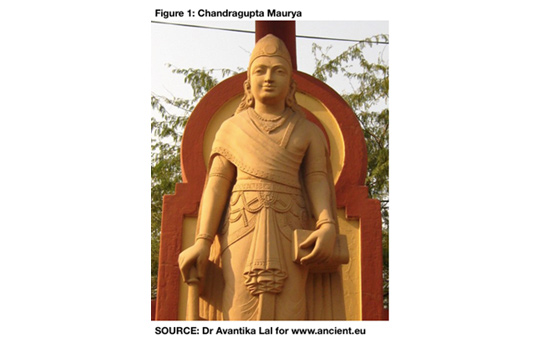 Chandragupta Maurya
Chandragupta Maurya
In an attempt to advance friendly relations and
improve trade with kingdoms across the seas, he married the daughter of
Seleucus. This proved to be a beneficial alliance because Seleucus ended up
surrendering a significant amount of territory to him. (https://www.amarchitrakatha.com/blog/chandragupta-maurya-story/ (accessed on 23rd December 2019).
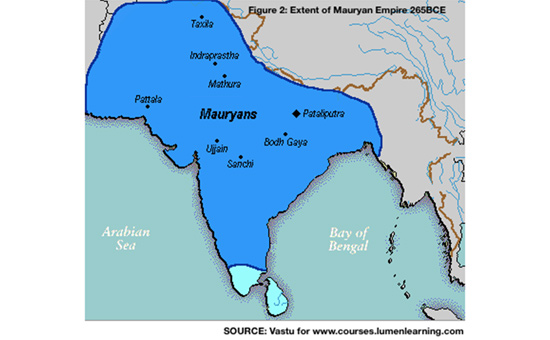 Extent of Mauryan Empire
Extent of Mauryan Empire
KING ASHOKA and HIS CONTRIBUTIONS
Bindusara died in 272 BCE, and was succeeded by his
son, Ashoka (304-232 BCE). As monarch, he was ambitious and aggressive.
But it was his conquest of Kalinga (262-261 BCE) that
proved to be the pivotal event of his life.
Hundreds of thousands of people were adversely
affected by the destruction and fallout of war. When he personally witnessed
the devastation, he embraced the teachings of Buddhism, and renounced war and
violence. He sent out missionaries to travel around Asia and spread Buddhism to
other countries.
Perhaps, one of the greatest-known accomplishments of
Ashoka was the creation of his edicts, which were erected between 269 BCE and
232 BCE. Set in stone, they are found throughout the Subcontinent. Ranging from
as far west as Afghanistan in the west to Andhra (Nellore District) in the
south.
Ashoka’s edicts state his policies and accomplishments. The edicts mention social and cultural attributes of his empire, emphasizing Buddhism, though not condemning other traditions. (https://courses.lumenlearning.com/boundless-worldhistory/chapter/the-maurya-empire/ (accessed 22nd December 2019)
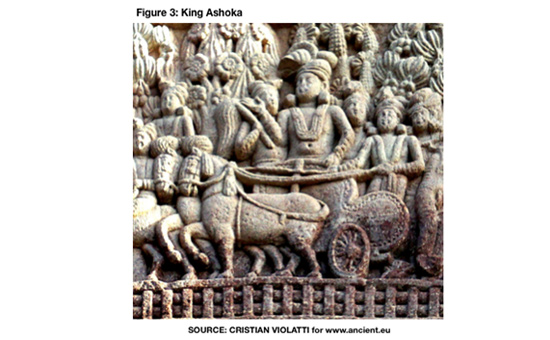 King Ashoka
King Ashoka
In addition to his edicts, Ashoka built stupas,
monasteries, and other religious structures at noteworthy Buddhist sites, such
as Sarnath.
He efficiently managed a centralised government from
the Mauryan capital at Pataliputra. A large bureaucracy collected taxes.
Inspectors reported back to the emperor. Irrigation expanded agriculture.
Familiar hallmarks of ancient empires, excellent roads were built connecting
key trading and political centres; Ashoka ordered that the roads have trees providing shade, wells, and inns.
(https://www.nationalgeographic.com/culture/people/reference/ashoka/ (accessed
22nd December 2019).
KALINGA WAR: TWO VIEWS
Kalinga war happened during the 12th year reign of
King Ashoka. Kalinga was an autonomous zone as it had seceded from Magadha. It
was prosperous and a coastal zone. There are references in the Mahabharata
about Kalinga. Mentioned in the Mahabharata, Kalinga probably played host to
more than one small kingdom.
Two early capitals were at Dantapura and Rajapura, and
the kingdom is said to have originated from King Vali, who may have been the
king of Magadha. (https://www.historyfiles.co.uk/KingListsFarEast/IndiaKalinga.htm
(accessed on 23rd December 2019)
Ashoka invaded Kalinga to complete the political
unification of India. Since Kalinga territory was like the land bridge between
the north and the south, its conquest could result in safe passage for the
Magadha army for aggression in the far south. The existence of a powerful
independent state touching upon the Magadha territory was like a direct threat
to Mauryan imperialism.
(http://www.historydiscussion.net/history-of-india/what-are-the-causes-of-the-kalinga-war/2415
(accessed on 23rd December 2019)
Kalinga war as described generally: During the time of Chandragupta, the Mauryan army
contained 6 lakh of infantry, 30 thousands cavalry, 9 thousand elephants and 8
thousand war chariots. By the time of Ashoka, the size of the army could have
been much larger, with fighting forces from all parts of the empire. Some
historians suggest that his army also contained mercenaries from Syria and
Bactria. (http://www.historydiscussion.net/history-of-india/what-are-the-causes-of-the-kalinga-war/2415
(accessed on 23rd December 2019)
The Kalinga army had only 60,000 infantry, 1,000
cavalry and 700 elephants. On the other hand, the Greek ambassador Megasthenes
mentions the military strength of Kalinga to be of about one lakh, which
consisted of 1700 horses, thousands of elephants, and 60 thousand soldiers.
Kalinga also had a powerful naval force.
Ashoka became victorious and, as a result ruled
Kalinga. Ashoka saw the blood-filled battlefield with his own eyes. 100,000
lost their lives and 1,50,000 were taken as prisoners.
An equal number of Mauryan soldiers died. He saw the
corpses of horses, elephants and soldiers in the battlefield. Countless people
suffered due to the war. The whole of Kalinga was destroyed in front of his own
eyes. He conquered Kalinga but there was not a single man left to live a life
of slavery.
The Kalinga War prompted him to devote the rest of his
life to non-violence (Ahimsa) and to victory through Dhamma (Dhamma-Vijaya). He
became a follower of Buddhism. (https://www.mapsofindia.com/history/battles/kalinga-war.html
(accessed on 23rd December 2019)
Kalinga war - An Alternate
view
According to Sri Lankan writer Daya Dissanayake,
author of "Who is Ashoka?”, Kalinga war may not have taken place. He said that the rock edict at Daya River in Odisha does not mention about Kalinga War. Instead the incident has been mentioned at a rock edict far away from Odisha. (https://indiaeducationdiary.in/no-evidence-to-suggest-kalinga-war-took-place-asoka-book-author-daya-dissanayake/ (accessed on 24th December 2019)
According to Biswa Bhusan Harichandan; BJP leader, the Kalinga war may have been a fiction. He said, “If one lakh soldiers were killed in the war, one lakh injured and more than 1.5 lakh imprisoned, then the Kalinga army must have had a strength of more than eight lakh. If you take that, the strength of the army would have been one third of Kalinga's population. It looks strange. Besides, there must have been a powerful king. There are some historians who argue that Kalinga was a kind of federation at that time and no one king ruled. If that is so, who was the prime minister of that federation or who was the leader. These questions need to be answered.” https://www.telegraphindia.com/states/odisha/kalinga-war-a-myth/cid/1391237 (accessed on 24th December 2019)
Noted author Sanjeev
Sanyal wrote about Ashoka
in Swarajyamag, “This was followed by four years of a bloody civil war in which Ashoka seems to have killed all male rivals in his family. Buddhist texts mention that he killed ninety-nine half-brothers and only spared his full brother Tissa.”
“The reader will be surprised to discover that the narrative about this conversion is almost certainly false. Ashoka would invade Kalinga in 262BC whereas we know from minor rock edicts that Asoka had converted to Buddhism more than two years earlier. Even Ashoka’s eulogists like Charles Allen agree that his conversion predated the Kalinga war. Moreover, he seems to have had links with Buddhists for a decade before his conversion. The evidence suggests that his conversion to Buddhism was more to do with the politics of succession than with any regret he felt for sufferings of war.”
Sources of
History
Literary: Literary sources, are all written records in the form
of texts, essays or descriptions, manuscripts, epics, etc.
Epigraphic: Epigraphy is the
science of identifying graphemes, clarifying their meanings, classifying their
uses according to dates and cultural contexts, and drawing conclusions about
the writing and the writers. So, these evidences are the ones identified on
inscriptions, clay tablets, etc.
Archaeological
sources: Archaeological
sources are basically the material evidence like historical buildings, coins,
inscriptions and other remains that gives important and detailed information
pertaining to a particular period.
Literary Sources
Kautilya’s Arthashastra
Kautilya
was the Prime Minister of Chandragupta Maurya. Chandragupta founded the Mauryan
Empire with his help. Arthashastra was written by
him.
It is the most important source for writing the history of the Mauryas and is divided into 15 Adhikarnas or sections and 180 Prakaranas or subdivisions. It has about 6,000 slokas. The book was discovered by Shamasastri in 1909 and ably translated by him. It is a treatise on statecraft and public administration.
Despite
the controversy over its date and authorship, its importance lies in the fact
that it gives a clear and methodological analysis of economic and political
conditions of the Mauryan period. The similarities between the administrative
terms used in the Arthashastra and in the
Ashokan edicts certainly suggests that the Mauryan rulers were acquainted with
his work.
As such
his Arthashastra provides useful and reliable information regarding the social
and political conditions as well as the Mauryan administration. (http://www.historydiscussion.net/empires/the-history-of-the-mauryan-empire-in-india/622
(accessed on 13th December 2019)
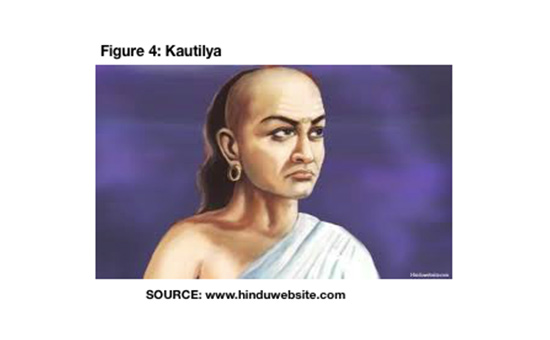 Kautilya
Kautilya
Mudra Rakshasa
“Signet Ring of the Rakshasa, the chief minister of the last Nanda king”, a historical play in Sanskrit by Vishakhadatta (4th century CE) narrates the ascent of the king Chandragupta Maurya to power in Northern India. (http://www.sanskritebooks.org/2009/06/mudrarakshasa-of-visakhadatta-sanskrit-drama-with-english-translation/
(accessed on 13th December 2019)
Indica
Megasthenes stayed, as Ambassador of Seleucus, at Chandragupta Maurya’s court at Pataliputra for several years around 300 B.C.
His book Indica, which he wrote as a keen-witted observer, survived only as fragments quoted by Diodorus, Strabo and, in particular, by Arria. Of particular interest is Megasthenes’ detailed description of seven ‘divisions’ of the Indian society. They depict a fascinating and, in fact the earliest detailed description of the Indian society, as observed by a foreign visitor to India’s capital and its surroundings. According to Megasthenes, the Indian society of those times
were divided into seven classes comprising of:
1. the ‘Sophists’ (Megasthenes’ description of this class is akin to that of priests)
2. the
farmers
3. the
herdsmen, who dealt with livestock and were basically nomads
4. the
artisans and shopkeepers (this class also included shipwrights and sailors)
5. the
soldiers
6. the
over-seers (who reported about the happenings in different parts of the empire
to the king)
7. the
class of people involved in deliberating about public affairs with the king and
play a role in selecting rulers, treasurers and other office-bearers of the
administration
Source (http://cw.routledge.com/textbooks/9780415485432/3.asp
(accessed on 13th December 2019)
Buddhist Literature
Buddhist texts provide many illustrations of Ashoka's role in giving donations to the Sangha, redistributing the Buddha's relics, and calling the third Buddhist council at Pataliputra. With Ashoka's support, Buddhist missionaries also led by his own son Mahindra and daughter Sanghamitra expanded the network of Buddhist monastic institutions throughout the Mauryan empire and in Sri Lanka, Kashmir, Gandhara, and the Swat Valley. (Source: https://www.studyandscore.com/studymaterial-detail/sources-of-mauryan-history-inscriptions-and-literature (accessed on 13th December 2019)
Buddhist
texts such as Jatakas reveal socio-economic conditions of Mauryan period while
Buddhist chronicles Mahavamsa and Dipavamsa throw light on the role of Ashoka
in spreading Buddhism to Sri Lanka.
Divyavadam, the Tibetan Buddhist text, tells about Ashoka’s efforts in spreading Buddhism.
INSCRIPTIONS
Inscriptions are basically writings, scriptures and
drawings on monoliths, stones and
relatively hard materials and act as an important source for history as they
tell us about aspects varying from messages, ownership of property, victories
over other kingdoms, hymns, shlokas, story of the monument, praises on the king
and much more to add on to the list.
Inscriptions
are mainly found as Rock
edicts and Pillar inscriptions and the languages used are mainly Prakrit, Pali
and Sanskrit. These inscriptions provide insights on:
1. Extent:
Ashoka’s inscriptions on stone monuments have been found in northwestern Pakistan and eastern Afghanistan, western India (Gujarat and Maharashtra), southern India (Karnataka and Andhra Pradesh), and eastern India (Orissa), demonstrating a network of administrative control radiating outwards from Pataliputra. These inscriptions were written in various dialects of Prakrit and are the earliest examples of writing in the Brahmi and Kharosthi scripts. Bilingual translations in Greek and Aramaic at Kandahar and Aramaic inscriptions in eastern Afghanistan illustrate the importance of spreading his messages to the inhabitants in their own languages. https://depts.washington.edu/silkroad/exhibit/mauryans/essay.html
(accessed on 13th December 2019)
2.Policies: Sets of major and minor rock edicts, inscriptions on polished sandstone pillars, and inscriptions in caves record public proclamations of Ashoka's moral and administrative policies, declarations to the Buddhist community (sangha), and donations to the Ajivikas (another heterodox community that received Mauryan patronage).
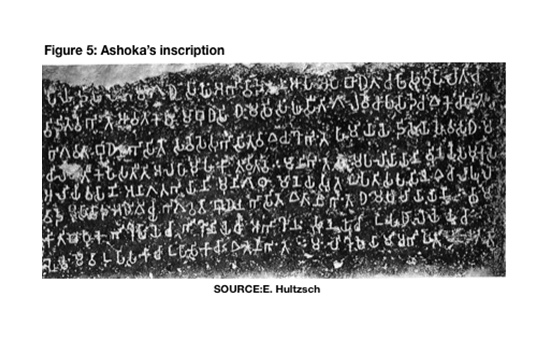 Ashoka’s inscription. Source Hultzsch.
Ashoka’s inscription. Source Hultzsch.
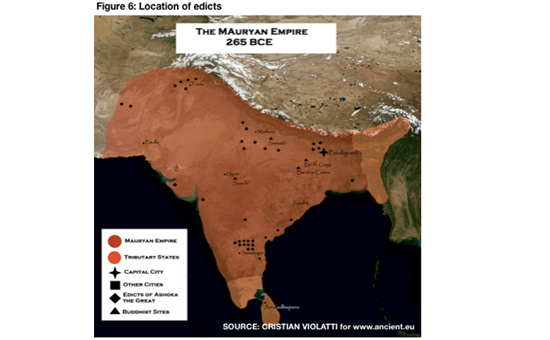 Mauryan Empire 265 BCE
Mauryan Empire 265 BCE
Inscriptions on Ashoka's 14 Rock Edicts (Re-produced from
http://www.historytuition.com/the_mauryan_empire/ashokas_14_rock_edicts.html)
1. Declares
prohibition of animal sacrifice; also prohibits the holding of festivals; royal
hunting was discontinued; only 2 peacocks and deer were killed in the kitchen
of beloved of Gods.
2. It
mentions medical treatment of humans and animals; also mentions construction of
roads, wells etc and also tree planting.
3. It
mentions about the Pradeshikas, Rajuks and Yuktas; declares the liberty towards
Brahmanas and the Sramanas.
4. It
mentions that the Beri Ghosa has been replaced by dharma gosha. It also
mentions that the Rajuks had the power to punish.
5. Reference
to the appointment of Dhamma mahatmas for the first time in the 14th year of
his regime. It also mentions that Dhamma Mahatmas promoting the welfare of
prisoners.
6. Mantri parishad has been mentioned; officials like Pulisani and Pratividikar has also been mentioned; it mentions “All Times I am available to the Mahamattas” - Mahamattas could bring their report to the king at any time.
7. It
mentions religious toleration amongst all the sects; it gives information that
tension among the sects was expressed intensely; it gives information about
self-centre and purity of mind.
8. In his
10th Regnal year Ashoka went to Dharmyatras to Sambodhi in Bodhgaya.
9. It
mentions about the uselessness of the various ceremonies; it stresses on
morality and moral code of conducts; it also mentions about the ceremony of
Dhamma; it includes regards for slaves and servants, respect for teachers, restrained
behaviour towards living beings and donation to Sramanas and the Brahmanas.
10. It
mentions that the king desires no more fame or glory except in the field of
Dhamma; it mentions about the supreme quality of Dhamma policy.
11. It
further explains the policy of Dhammas; it emphasizes on giving respect to the
elders, abstain from killing animals and liberalism and charity towards
friends, Sramanas and Brahmans and good behaviour towards slaves and servants.
12.
Ithijika Mahamatta has been mentioned; appeal for toleration among sects to
honour the other sects; it mentions that the beloved of the Gods does not
consider gifts or honor to be as important as the progress of the essential
doctrines of all sects.
13. King
considered the victory by Dhamma to be the foremost victory; mentions the Dhamma victory on the Greek being named
Antiochus; it also mentions the Dhamma victory over:
Ptolemy
II Philadelphus- King of Egypt (285-247 BC)
Alexander – King of Epirus (273-255 BC)
Antigonous
Gonatus –
King
of
Macedonia (276-239 BC)
Magas – King of
Cyrene
It also
mentions the Dhamma victory in south over the Cholas and Pandyas as far as
Ceylon; the 2nd & 13th
Rock Edict mentions Pandyas, Cholas had Dhamma victory
over Ceylon.
XIV: The
purpose of the Rock Edicts has been mentioned.
Source: (http://www.historytuition.com/the_mauryan_empire/ashokas_14_rock_edicts.html
(accessed on 13th December 2019)
CONCLUSION
Powered by Chanakya’s political astuteness, while Chandragupta
Maurya successfully overthrew the Nanda dynasty,
the Mauryan kings went on to rule almost the entire
Indian subcontinent. The Mauryan period is considered to be the greatest since
the kingdom grew into a powerful one and also excelled in administrative
reforms.
Chanakya, the political advisor of Chandragupta
Maurya authored ‘Arthashastra’. Arthashastra is a
treatise on statecraft, economic policy and military strategy, written in Sanskrit.
The ‘Indica’ authored by Greek traveller and historian Megasthenes present a detailed picture of the social, economic and administrative maturity of the Mauryan Empire. Chandragupta Maurya’s successor Bindusara improved trade relations with neighbouring kingdoms and used marriage alliances with other kingdoms to annex them.
Bindusara was succeeded by his son, Ashoka who became an active exponent of peace and non-violence. Apart from the edicts and stupas, monasteries and other religious buildings were also constructed during Ashoka’s reign.
This project was done by Chettinad Hari
Shree Vidyalayam, Chennai. The
group consisted of Gitanjali
Naveen, Divya Chidambaram, Uttara Stefanie Prakash, Riti Sivakumar, Eesha Shah
and Chandana J.
Readers are requested to
kindly consider the following:
1. These papers are submitted by students of Grade 9 (age group: 14-15
years). Their efforts may not be comparable with professional research work and
rigour.
2. This is the first time that these students have attempted studies on
these topics with comparatively limited access to reference materials and
resources, as compared to professional and advanced research initiatives.
3. Two key limitations faced by the students include:
i) Working primarily within the school premises, with no opportunity for
field-research or interviews with domain experts
ii) Time limitations, given academic commitments.
4. Citations and sources of references have been included in the
reports. However, in case any source or citation has been missed out, the same
is purely inadvertent, accidental or due to ignorance.
The above paper submitted by the students is part of an initiative called ‘Utsav’ conducted by the school aimed at developing awareness, interest and orientation for Indic wisdom, knowledge, history and philosophy, among students.
To
read all articles by students